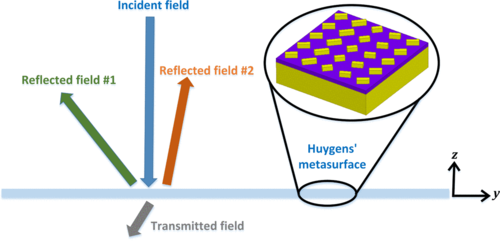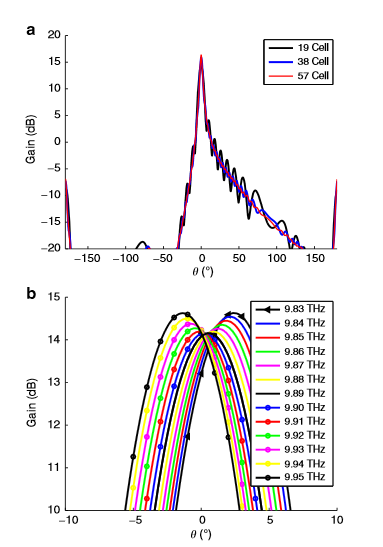January 22, 2014
It’s elementary-school science: shine a laser at a mirror—the angle of incidence equals the angle of reflection. Right?
Not anymore. Professor George Eleftheriades of The Edward S. Rogers Sr. Department of Electrical & Computer Engineering and PhD candidate Minseok Kim and post-doctoral fellow Alex Wong have just shown how surfaces can be tailored to control magnitude, direction and delay, or phase, of the reflected light.
“We’ve designed a surface that can process light completely,” says Professor Eleftheriades. “This is a new field and we’ve managed to achieve this full control for the first time, so we’re very excited.”
In a recent paper published in the journal Physical Review X, the researchers presented a new metamaterials surface composed of normal backing and glass with little gold reflective rods printed on top. The gold rods vary in size (from 50 to 150 nanometres) and orientation, allowing tuning of both electric and magnetic response.

Past research in this area has shown how to control the phase of reflected light, but not the magnitude. “We were able to control both, and this is the first time that anyone has shown full control of light reflection,” says Professor Eleftheriades.
These new surfaces could improve high-resolution medical imaging and telecommunications—for example, by allowing for beams that have a specific shape and direction, or creating custom beam-splitters and other more exotic optical devices such as optical phased arrays.
“The future of these surfaces is to make them tunable, to enable us to dynamically change their reflection properties in real time—that is the next step,” says Professor Eleftheriades.

The ‘controlling’ element on the new reflective surface is gold, a metal. Alternative approaches to control light have relied on antennas. However, the field of optics has long been challenged to create a powerful antenna for light—avoiding metals, which dissipate energy as heat and thus make conventional radio-frequency antennas not scalable to tera-Hertz (THz) and light wave frequencies. Overcome this difficulty calls for an antenna made of low-loss dielectrics, such as glass.
To solve the problem effectively, Professor Eleftheriades and PhD student Mohammad Memarian needed to control the same two properties: electric and magnetic response. But how to create magnetic response, typically requiring conducting loops, using only dielectric materials?
Their solution is a photonic crystal that creates magnetic response via the geometry of its dielectric components. The result is an optical antenna that can transmit signals from GHz to THz and all the way up to light wave frequencies, in all directions—scanning continuously from backward through broadside and forward directions, as the colour of the light varies.
“The innovation here is that we managed to create a leaky-wave antenna with photonic crystals but allowing full scan control in space,” says Professor Eleftheriades. “Our set-up propagates a signal through space without losing any of its strength, at many different frequencies and directions.” Such an optical leaky-wave antenna can find applications in telecommunication and spectroscopy.
Their work appeared in the January 2015 issue of Nature Communications.
More information:
Marit Mitchell
Senior Communications Officer
The Edward S. Rogers Sr. Department of Electrical & Computer Engineering
416-978-7997; marit.mitchell@utoronto.ca